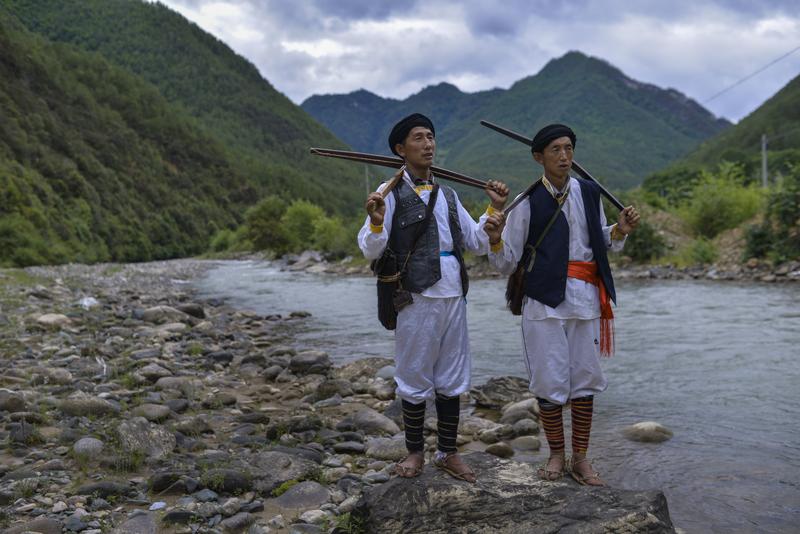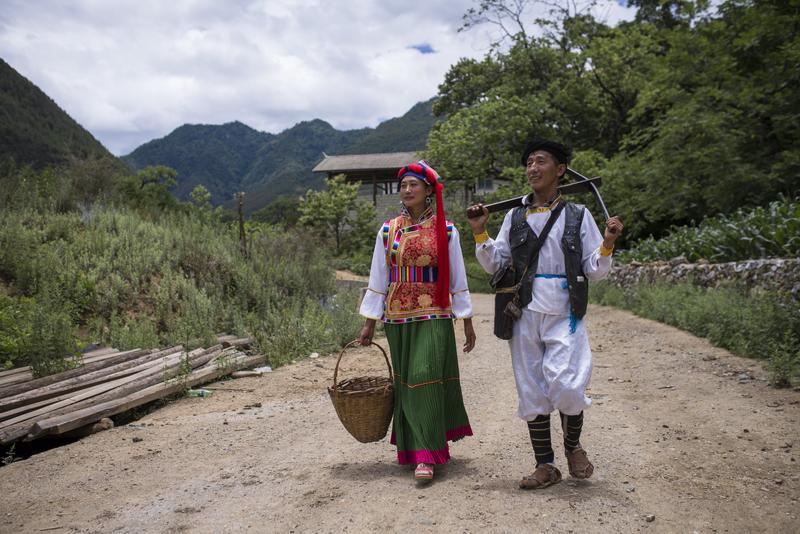Mix of ethnic groups gives Yunnan a special cultural flavor, report Cheng Yuezhu in Beijing and Li Yingqing in Kunming.
 Malimasa people clad in traditional attire. Mostly living in Tacheng town, Yunnan province, they are known for their ability to speak at least five languages. (PHOTO PROVIDED TO CHINA DAILY)
Malimasa people clad in traditional attire. Mostly living in Tacheng town, Yunnan province, they are known for their ability to speak at least five languages. (PHOTO PROVIDED TO CHINA DAILY)
The Nujiang Grand Canyon in Yunnan province, with its sublime beauty, is now lauded by fans of road trips who would like to drive on the highway along the Nujiang River and listen to the sound of roaring water gushing between the banks.
There, the mountains are green in the summer, and concealed within are not only myriad natural wonders and fascinating creatures but also diverse ethnic cultures, a phenomenon shaped by Yunnan's geography.
One such hidden place is Dimaluo, a rustic village in Gongshan Derung and Nu autonomous county, known for its diverse ethnic groups and religions.
With a total population of slightly more than 2,000, the mixed settlement mainly comprises people from a number of ethnic groups, including Tibetan, Nu, Han, Derung, Lisu, Bai and Naxi. Many people follow Tibetan Buddhism and Christianity.
 Malimasa people clad in traditional attire. Mostly living in Tacheng town, Yunnan province, they are known for their ability to speak at least five languages. (PHOTO PROVIDED TO CHINA DAILY)
Malimasa people clad in traditional attire. Mostly living in Tacheng town, Yunnan province, they are known for their ability to speak at least five languages. (PHOTO PROVIDED TO CHINA DAILY)
According to Zhou Xuebing, a lecturer at Southwest Forestry University, who has been conducting field research in Dimaluo and the neighboring areas since 2019, the village has people who follow the two religions, because of a history of migration.
"Dimaluo is a word from the Nu language, meaning 'valley of flowing water'," Zhou says. "Previously, the Nu ethnic group lived a semi-farming and semi-hunting lifestyle. According to the senior Nu locals, their ancestors found this place during hunting. Because its environment was suitable for farming and living, they settled down here."
Later, people from the Tibetan ethnic group moved into the village and brought Tibetan Buddhism. At the end of the 19th century, French missionary Annet Genestier preached Catholicism in the area and built the Baihanluo church, now a cultural landmark. In the early 20th century, Lisu people settled in the village and brought more Christianity along.
"After the founding of the People's Republic of China in 1949, the national policies of ethnic equality, unity and freedom of religious belief have promoted the harmony of the local ethnic groups, and formed the pattern where different ethnic cultures and religions coexist," Zhou says.
"Now this feature has become an important asset for local culture and tourism, attracting a large number of tourists to the area and increasing the locals' income. The driving force of the tourism economy has also in turn consolidated the multiethnic patterns."
While Dimaluo provides a miniature of ethnic diversity across Yunnan, a particular branch of the Naxi ethnic group called Malimasa serves as the human embodiment. People from this community are known for their ability to speak at least five languages.
He Wenqi, 77, from the Malimasa community, has been conducting research on his ethnic identity since 2003.
"Each of us can speak five languages-Mandarin, Tibetan, Naxi, Lisu and our unique Malimasa language. Some can speak two more-the languages of the Bai and Yi ethnic groups," he says.
"Sometimes people from different places might have trouble understanding one another. That's when we, Malimasa people, can interpret for them. Whenever we encounter other ethnic groups, we speak their language."
With a population of more than 2,100, Malimasa people mainly live in Tacheng town, Weixi Lisu autonomous county. Their villages intersperse with those inhabited by other ethnic groups, and it has become a custom for them to learn several languages to facilitate communication.
Chen Zhaofa, deputy head of Tacheng town, says the region plans to build a Malimasa exhibition hall that will display the culture and history of the community and host performances to tell their stories.
Of China's 56 ethnic groups, Yunnan is home to people from 26. In history, varied primeval ethnic groups migrated into the region and mixed with the aboriginals, according to Gao Zhiying, a professor at Yunnan University, who specializes in history and cultural studies of ethnic groups.
"The high mountains and deep valleys in Yunnan also made it difficult for the ethnic groups to interact with one another after they entered the area, resulting in the formation of ethnic groups with distinct cultural characteristics and made Yunnan's cultural diversity particularly outstanding," Gao says.
Contact the writers at chengyuezhu@chinadaily.com.cn


